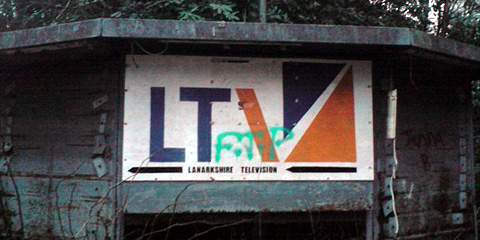Thursday 4 April, 2013, 22:05 - Licensed, Spectrum Management, Chart Predictions
Posted by Administrator
Posted by Administrator
 It is now only a month or so before the annual pan-European musical bun fight that is the Eurovision Song Contest (which is on the 18th of May). The 39 songs that have made it to the competition (which this year is in Malmo, Sweden) are now available to listen to online - with many having professionally produced videos viewable on YouTube. As always there is a mix of complete Euro-nonsense (Greece with their song Alcohol Is Free), songs that could have been written for Eurovision any time from 1960 to the present day (Switzerland's song You And Me falls into this category) copies of last year's winner in the hope that people will want the same thing again this year (Germany's Glorious for example), sickly pop songs with no real substance (Finland's Abbaesque entry Marry Me) and this year, it seems, a whole swathe of rather nice ballads.
It is now only a month or so before the annual pan-European musical bun fight that is the Eurovision Song Contest (which is on the 18th of May). The 39 songs that have made it to the competition (which this year is in Malmo, Sweden) are now available to listen to online - with many having professionally produced videos viewable on YouTube. As always there is a mix of complete Euro-nonsense (Greece with their song Alcohol Is Free), songs that could have been written for Eurovision any time from 1960 to the present day (Switzerland's song You And Me falls into this category) copies of last year's winner in the hope that people will want the same thing again this year (Germany's Glorious for example), sickly pop songs with no real substance (Finland's Abbaesque entry Marry Me) and this year, it seems, a whole swathe of rather nice ballads. For what it's worth, Wireless Waffle is particularly fond of the Icelandic entry (Ég á Líf), the video for which awaits your enjoyment below. If you are of an emotionally sensitive disposition, make sure you have some tissues to hand.
Our selection of songs that ought to be in the top 5, at least if they are able to reproduce the performance in their videos on stage on the night are:
- Eyþór Ingi Gunnlaugsson - Ég á Líf (Iceland)
- Roberto Bellarosa - Love Kills (Belgium)
- Zlata Ognevich - Gravity (Ukraine)
- Despina Olympiou - An Me Thimáse (Cyprus)
- Dina Garipova - What If (Russia)
What has become more complex, though, is the use of wireless technology for the event. Whilst it's still normal in a concert hall to use wired cameras, the use of radiomicrophones and in-ear monitors (which allow the performer to hear themselves sing without the noise of the surrounding environment) has grown significantly over recent years. Figures provided in response to a European Commission consultation on programme making spectrum show an average annual growth of 12% in the number of such devices employed over the past 15 years (but nearly 40% growth per year over the last 4 years).
| Year | Venue | Radiomicrophones used | In-Ear Monitors used |
|---|---|---|---|
| 1998 | Birmingham, UK | 40 | 2 |
| 1999 | Jerusalem, Israel | 42 | 6 |
| 2000 | Stockholm, Sweden | 48 | 16 |
| 2001 | Copenhagen, Denmark | 48 | 16 |
| 2002 | Tallinn, Estonia | 54 | 16 |
| 2003 | Riga, Latvia | 54 | 16 |
| 2004 | Istanbul, Turkey | 54 | 16 |
| 2005 | Kiev, Ukraine | 54 | 16 |
| 2006 | Athens, Greece | 54 | 16 |
| 2007 | Helsinki, Finland | 56 | 16 |
| 2008 | Belgrade, Serbia | 56 | 16 |
| 2009 | Moscow, Russia | 56 | 16 |
| 2010 | Oslo, Norway | 72 | 32 |
| 2011 | Düsseldorf, Germany | 82 | 40 |
| 2012 | Baku, Azerbaijan | 104 | 80 |
What is driving this growth? One the one hand, the equipment costs are coming down making it more affordable to use wireless microphones. On the other, it's also probably true that in earlier years, microphones would be passed from one user to another as they went on/off stage whereas now each artist and band has their own set of equipment which is tailored to their own needs.
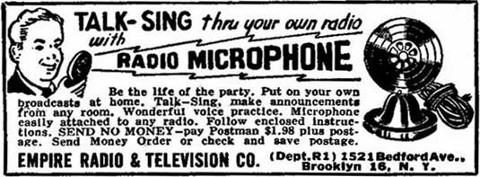
Equipment is one thing, but what about the radio spectrum issues? Radiomicrophones and in-ear monitors are normally analogue (for reasons that can wait for another day) and use around 200 kHz of spectrum each. If all the devices in Baku (184) were turned on at the same time, they would need 37 MHz of spectrum just to exist. But this is not the full story. Firstly, if devices were 200 kHz apart, there would be not a sliver of a gap between them. Whilst they could all successfully transmit, even the smartest digital receivers would find it difficult to separate them from each other - and we aren't dealing with digital technology. In reality, frequencies are separated by at least 300 kHz and often more to allow the receivers room to breathe.
The situation is even worse than this however. Due to the close proximity of devices to each other, and of devices to receivers, there is a tendency for lots of intermodulation to occur. If you assume that each 200 kHz channel that can be used is numbered, starting at 1 then you can't use the adjacent channel because it's too close. You also, because of intermodulation, can't use any channel which represents the difference or sum of twice the value of one channel being used minus another channel being used. As and example:
- If you are using channels 1 and 3 (channel 2 is adjacent to channel 1, so you can't use that), you can't use channel 4 (as its adjacent to 3) or channel 5 (as its 2*3-1). The next available channel is 6.
- If you are using channels 1, 3 and 6, you now also can't use channel 7 (adj to 6). The next available channel is 8.
- If you are using channels 1, 3, 6 and 8 you now can't use channels 9 (adj to 8), 10 (2*8-6) or 11 (2*6-1). The next available channel is 12.
The diagram below shows the situation. Green channels are those in use. Red channels are adjacent channels that can't be used. Purple channels are intermodulation products. Pink channels are both at the same time!
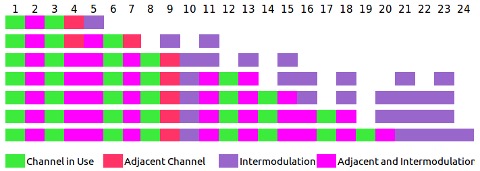
In the example given above, out of 24 available channels, only 8 are useable. Actually, if you extended the diagram at this point you would find that another 10 channels are already 'wallied out' because of intermodulation. So 8 transmitters has used 34 frequencies! The relationship between the number of transmitters on-air and the number of channels sterilised is not linear but in general something of the order of 1 frequency in 5 can be used for radiomicrophones where they are packed densely in a given location if these problems are to be avoided.
This represents pretty poor frequency efficiency but is fairly representative of what is achieved in real life, which is that only something like one fifth of any spectrum available for radiomicrophones or in-ear monitors can be used in any one venue at the same time. Returning to Baku then, the amount of spectrum required is not 37 MHz, but to support 184 devices simultaneously would require more like 184 MHz of spectrum: give or take 1 MHz per device!
Most radiomicrophones (and in-ear monitors) operate in and amongst television broadcasts in the UHF band which notionally runs from 470 to 862 MHz. In many countries, however, the upper end of this band from 790 MHz upwards has now been set-aside for mobile broadband services, leaving 320 MHz remaining for television broadcasting (and of course radio microphones).
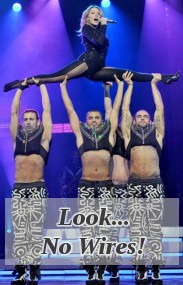 Azerbaijan, last year's host of the Eurovision, is yet to switch over to digital TV and equally has not yet used the upper part of the UHF TV band for mobile services and so finding 180 MHz of spectrum for radiomicrophones is presumably not that difficult. In 2013, however, the contest is in Malmo, Sweden. Not only has Sweden cleared the upper part of the UHF band for mobile services, but it has also gone over to digital broadcasting. Malmo is virtually on the border between Sweden and Denmark meaning that the local TV spectrum will be occupied not only by the 8 Swedish multiplexes but by the Danish ones too. Finding 180 MHz of spectrum for this year's competition is therefore much more challenging.
Azerbaijan, last year's host of the Eurovision, is yet to switch over to digital TV and equally has not yet used the upper part of the UHF TV band for mobile services and so finding 180 MHz of spectrum for radiomicrophones is presumably not that difficult. In 2013, however, the contest is in Malmo, Sweden. Not only has Sweden cleared the upper part of the UHF band for mobile services, but it has also gone over to digital broadcasting. Malmo is virtually on the border between Sweden and Denmark meaning that the local TV spectrum will be occupied not only by the 8 Swedish multiplexes but by the Danish ones too. Finding 180 MHz of spectrum for this year's competition is therefore much more challenging.But move forward 10 years and then what will happen. For starters, at the current rate of growth, and assuming no improvement in the spectrum efficiency of wireless microphone technology, there will be a requirement for 560 MHz of spectrum for the Eurovision. Secondly, the parts of the UHF TV band currently unoccupied and used for these purposes will be full of 'cognitive radio' devices hunting out every last vestige of unused spectrum. What will happen then? The simple fact is that no-one really knows, but the programme making community are worried, and understandably so. If there was a way around the intermodulation problem, then the amount of spectrum required would decrease, so perhaps now is the time for some enterprising RF engineer to find a solution to this problem so that we can continue to enjoy the pageantry of the world's greatest song contest. Either that or sing less? Some would argue that for the Eurovision that would be no bad thing.
add comment
( 1902 views )
| permalink
| 



 ( 3.1 / 7586 )
( 3.1 / 7586 )




 ( 3.1 / 7586 )
( 3.1 / 7586 )
Previous posts entitled 'What are the chances?' have mostly been about the chances of pirate 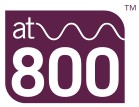 radio stations causing enough interference to merit the authorities tracking them down. In a sense, there is a certain similarity between that topic and the one discussed here as the question that's being explored today is 'What are the chances... of receiving interference from 4G networks at 800 MHz if you are a UK DTT viewer?' Rather a long title, but as of this week, an organisation called Digital Mobile Spectrum Limited (DMSL) who are badging themselves as at800 have been given £180 million specifically to try and answer exactly that question.
radio stations causing enough interference to merit the authorities tracking them down. In a sense, there is a certain similarity between that topic and the one discussed here as the question that's being explored today is 'What are the chances... of receiving interference from 4G networks at 800 MHz if you are a UK DTT viewer?' Rather a long title, but as of this week, an organisation called Digital Mobile Spectrum Limited (DMSL) who are badging themselves as at800 have been given £180 million specifically to try and answer exactly that question.
So what is the problem exactly? The UK has just auctioned spectrum which is colloquially known as the 'Digital Dividend'. This radio spectrum was previously used for television broadcasting, representing channels 61 to 69 inclusive (790 to 862 MHz). Many people have antennas and receivers that were receiving television pictures on those channels until very recently. As of now, these frequencies are going to be used for 4G mobile services. Once these services are on-air, there will be mobile base stations transmitting on frequencies which it is possible for set-top boxes and digital televisions to receive - though as mobile and television technologies are different, they won't receive pictures, just the signals (a bit like listening to a conversation in a foreign language - you can hear it but you can't decipher it).
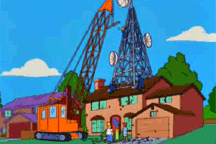 Under certain circumstances, it is possible that the 4G transmissions could cause interference to television (Freeview) reception. The circumstances are complex but generally if television transmissions on channel 59 or 60 are being used in a particular area, the receivers will be more susceptible to interference. If those receivers are close to a mobile base station transmitting at the lower end of the new 800 MHz mobile band, then interference could be caused (mobile operator 'three' have the frequencies at the bottom of the band most likely to cause a problem). Calculating who will be affected is therefore rather complex - it is a combination of which television transmitter they are watching, how far away from it they are, and how close to a three base station they are. Thus it is not straightforward to identify whose viewing might be disrupted.
Under certain circumstances, it is possible that the 4G transmissions could cause interference to television (Freeview) reception. The circumstances are complex but generally if television transmissions on channel 59 or 60 are being used in a particular area, the receivers will be more susceptible to interference. If those receivers are close to a mobile base station transmitting at the lower end of the new 800 MHz mobile band, then interference could be caused (mobile operator 'three' have the frequencies at the bottom of the band most likely to cause a problem). Calculating who will be affected is therefore rather complex - it is a combination of which television transmitter they are watching, how far away from it they are, and how close to a three base station they are. Thus it is not straightforward to identify whose viewing might be disrupted.
All is not lost though, as there is a way to solve the interference. The solution to the problem is to fit a filter which allows the television transmissions through but blocks the 4G signals. at800 have been given the money to help work out who will be affected and to pay for filters to be fitted. It has been estimated that up to almost 1 million UK television households could be affected. The key here is 'could be...' because experience in other countries where 800 MHz services have already been launched is that they have not led to the degree of interference problems that are predicted.
There is no doubt that some households will be affected, but the numbers could be well below 1 million. Those which are most susceptible are those which are in areas where television signals are already weak. In some of those areas, viewers will have fitted amplifiers to their TV antennas to boost the signal. These amplifiers are particularly susceptible to interference and can even be completely overloaded by strong 4G transmitters. Similar amplifiers are also used to distribute signals from a TV antenna to multiple television sockets. Some houses with multiple sockets may have an amplifier fitted and not even be aware of it. In blocks of flats the same idea applies. These situations will make fitting a filter more complex, but still feasible.
In some (rare) cases, it is possible that no amount of filtering will solve the problem. In these circumstances at800 has the power, and the money, to replace the terrestrial television system with an alternative such as cable or satellite.
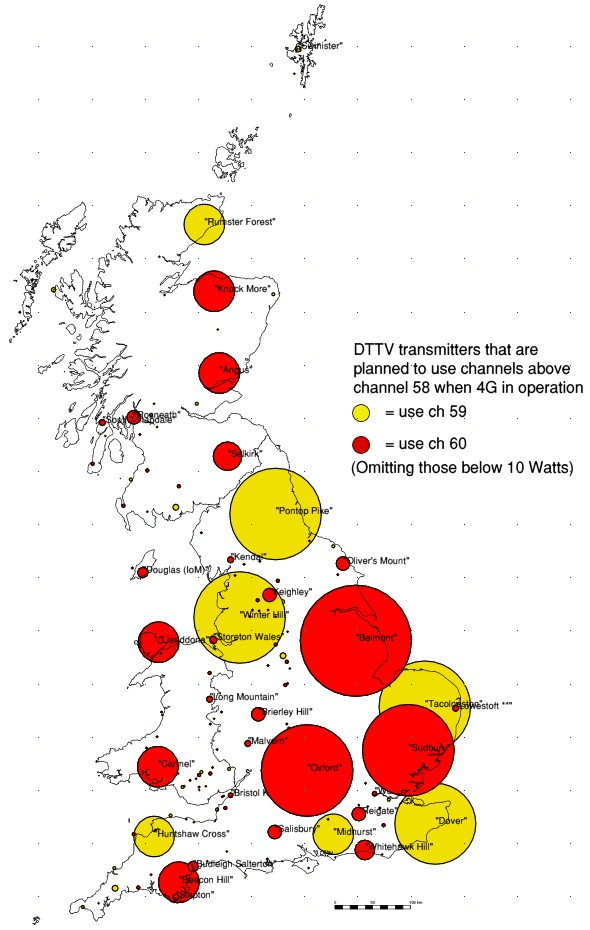 Should you be worried? Firstly, you need to understand whether the television transmitter in your area uses channels 59 or 60. The map on the right (click for a larger version) shows those television transmitter which will use these channels. If you are served by one of these transmitters then that puts you at a higher risk. If you are towards the edge of the coverage area then your risk is increased. If you are near a three base station your risk is further increased (sadly there is no simple way to determine this). If you are affected, what will you see? In a word... nothing! Your reception of any programmes transmitted on the frequencies represented by channels 59 or 60 will stop, dead. Alternatively, the picture might break up badly.
Should you be worried? Firstly, you need to understand whether the television transmitter in your area uses channels 59 or 60. The map on the right (click for a larger version) shows those television transmitter which will use these channels. If you are served by one of these transmitters then that puts you at a higher risk. If you are towards the edge of the coverage area then your risk is increased. If you are near a three base station your risk is further increased (sadly there is no simple way to determine this). If you are affected, what will you see? In a word... nothing! Your reception of any programmes transmitted on the frequencies represented by channels 59 or 60 will stop, dead. Alternatively, the picture might break up badly.
Unfortunately, losing reception or having bad reception is not necessarily evidence of interference from 4G base stations. It could be caused by a myriad of other problems. This is what makes the job of at800 that much more difficult. They will need to decide, when confronted with an apparent case of interference, whether 4G is the cause or whether it is something else. Their decisions on this will no doubt prove controversial!
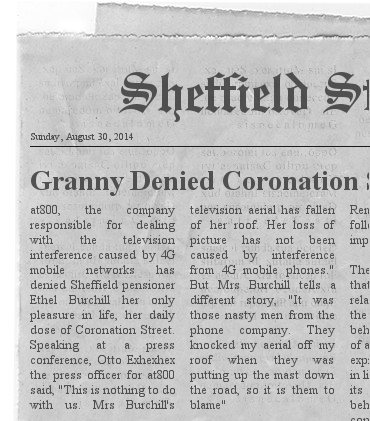
If you use satellite (Sky or Freesat) or cable then you don't need to worry. If you use Freeview, then perhaps now would be a good time to check your reception, at least then you will know whether anything changes.
 radio stations causing enough interference to merit the authorities tracking them down. In a sense, there is a certain similarity between that topic and the one discussed here as the question that's being explored today is 'What are the chances... of receiving interference from 4G networks at 800 MHz if you are a UK DTT viewer?' Rather a long title, but as of this week, an organisation called Digital Mobile Spectrum Limited (DMSL) who are badging themselves as at800 have been given £180 million specifically to try and answer exactly that question.
radio stations causing enough interference to merit the authorities tracking them down. In a sense, there is a certain similarity between that topic and the one discussed here as the question that's being explored today is 'What are the chances... of receiving interference from 4G networks at 800 MHz if you are a UK DTT viewer?' Rather a long title, but as of this week, an organisation called Digital Mobile Spectrum Limited (DMSL) who are badging themselves as at800 have been given £180 million specifically to try and answer exactly that question.So what is the problem exactly? The UK has just auctioned spectrum which is colloquially known as the 'Digital Dividend'. This radio spectrum was previously used for television broadcasting, representing channels 61 to 69 inclusive (790 to 862 MHz). Many people have antennas and receivers that were receiving television pictures on those channels until very recently. As of now, these frequencies are going to be used for 4G mobile services. Once these services are on-air, there will be mobile base stations transmitting on frequencies which it is possible for set-top boxes and digital televisions to receive - though as mobile and television technologies are different, they won't receive pictures, just the signals (a bit like listening to a conversation in a foreign language - you can hear it but you can't decipher it).
 Under certain circumstances, it is possible that the 4G transmissions could cause interference to television (Freeview) reception. The circumstances are complex but generally if television transmissions on channel 59 or 60 are being used in a particular area, the receivers will be more susceptible to interference. If those receivers are close to a mobile base station transmitting at the lower end of the new 800 MHz mobile band, then interference could be caused (mobile operator 'three' have the frequencies at the bottom of the band most likely to cause a problem). Calculating who will be affected is therefore rather complex - it is a combination of which television transmitter they are watching, how far away from it they are, and how close to a three base station they are. Thus it is not straightforward to identify whose viewing might be disrupted.
Under certain circumstances, it is possible that the 4G transmissions could cause interference to television (Freeview) reception. The circumstances are complex but generally if television transmissions on channel 59 or 60 are being used in a particular area, the receivers will be more susceptible to interference. If those receivers are close to a mobile base station transmitting at the lower end of the new 800 MHz mobile band, then interference could be caused (mobile operator 'three' have the frequencies at the bottom of the band most likely to cause a problem). Calculating who will be affected is therefore rather complex - it is a combination of which television transmitter they are watching, how far away from it they are, and how close to a three base station they are. Thus it is not straightforward to identify whose viewing might be disrupted. All is not lost though, as there is a way to solve the interference. The solution to the problem is to fit a filter which allows the television transmissions through but blocks the 4G signals. at800 have been given the money to help work out who will be affected and to pay for filters to be fitted. It has been estimated that up to almost 1 million UK television households could be affected. The key here is 'could be...' because experience in other countries where 800 MHz services have already been launched is that they have not led to the degree of interference problems that are predicted.
There is no doubt that some households will be affected, but the numbers could be well below 1 million. Those which are most susceptible are those which are in areas where television signals are already weak. In some of those areas, viewers will have fitted amplifiers to their TV antennas to boost the signal. These amplifiers are particularly susceptible to interference and can even be completely overloaded by strong 4G transmitters. Similar amplifiers are also used to distribute signals from a TV antenna to multiple television sockets. Some houses with multiple sockets may have an amplifier fitted and not even be aware of it. In blocks of flats the same idea applies. These situations will make fitting a filter more complex, but still feasible.
In some (rare) cases, it is possible that no amount of filtering will solve the problem. In these circumstances at800 has the power, and the money, to replace the terrestrial television system with an alternative such as cable or satellite.
 Should you be worried? Firstly, you need to understand whether the television transmitter in your area uses channels 59 or 60. The map on the right (click for a larger version) shows those television transmitter which will use these channels. If you are served by one of these transmitters then that puts you at a higher risk. If you are towards the edge of the coverage area then your risk is increased. If you are near a three base station your risk is further increased (sadly there is no simple way to determine this). If you are affected, what will you see? In a word... nothing! Your reception of any programmes transmitted on the frequencies represented by channels 59 or 60 will stop, dead. Alternatively, the picture might break up badly.
Should you be worried? Firstly, you need to understand whether the television transmitter in your area uses channels 59 or 60. The map on the right (click for a larger version) shows those television transmitter which will use these channels. If you are served by one of these transmitters then that puts you at a higher risk. If you are towards the edge of the coverage area then your risk is increased. If you are near a three base station your risk is further increased (sadly there is no simple way to determine this). If you are affected, what will you see? In a word... nothing! Your reception of any programmes transmitted on the frequencies represented by channels 59 or 60 will stop, dead. Alternatively, the picture might break up badly.Unfortunately, losing reception or having bad reception is not necessarily evidence of interference from 4G base stations. It could be caused by a myriad of other problems. This is what makes the job of at800 that much more difficult. They will need to decide, when confronted with an apparent case of interference, whether 4G is the cause or whether it is something else. Their decisions on this will no doubt prove controversial!

If you use satellite (Sky or Freesat) or cable then you don't need to worry. If you use Freeview, then perhaps now would be a good time to check your reception, at least then you will know whether anything changes.
Monday 28 January, 2013, 12:22 - Licensed
Posted by Administrator
In a shock decision, Ofcom today announced that Arqiva are to run the UK's local television multiplex. The winning company, called 'Comux' has won the licence to operate the transmission network that will support local television services. Not speaking to Wireless Waffle, a spokesperson for Ofcom was overheard to think,Posted by Administrator
"We like Arqiva, oops, we mean Comux's proposal. After all, Arqiva transmit 'X-Factor' which brings us a lot of business in dealing with complaints: without Arqiva a lot of us would be out of a job. We also like the idea of supporting monopolistic companies that pay no corporation tax in the UK. We are hoping that Starbucks will bid in the 4G auction we are running at the moment and that Network Rail will bid to run a mobile network for trains (What? They already do? Since when?)"
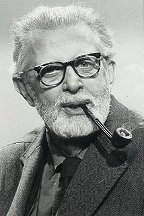 But wait, in their public justification for the award, Ofcom state (page 6 of the account of decision),
But wait, in their public justification for the award, Ofcom state (page 6 of the account of decision),Arqiva is not an applicant for the licence...
So is Comux really Arqiva, that is the question. Well they certainly share the same postal address: Arqiva/Comux, Chalfont Grove, Chalfont St. Peter, Gerrards Cross SL9 8TW.
OK, it's not exactly conclusive but the fact that they share an office surely means there are opportunities for them to share a lot more too! Collusion is a very dirty word, almost as dirty as tax avoidance.
Either way, here's raising a glass at local television in the UK. Let's just hope they bring back Old Country with Jack Hargreaves. What? You mean he's already dead? Since when?
Thursday 29 November, 2012, 04:07 - Licensed
Posted by Administrator
The local TV landscape in the UK is slowly taking shape as the decision on the final, and arguably the most commercially viable/advantageous franchises is delayed to give Ofcom more time to make the right decision. Whilst decisions on which companies will succeed in the lucrative markets of London, Leeds and Liverpool are still outstanding, also still to be announced is who will supply the transmission services for the local TV stations. Four bidders emerged when Ofcom invited tenders to deliver the local TV multiplexes:Posted by Administrator
 Avanti Local TV (backed by broadband satellite company Avanti Communications – plans to use small transmitters to provide coverage tailored to local TV audiences)
Avanti Local TV (backed by broadband satellite company Avanti Communications – plans to use small transmitters to provide coverage tailored to local TV audiences) Comux UK (backed by Canis Media who run the local TV multiplex in Manchester – a group of consultants who will provide their expertise to local TV companies to help them get going)
Comux UK (backed by Canis Media who run the local TV multiplex in Manchester – a group of consultants who will provide their expertise to local TV companies to help them get going)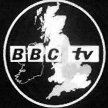 LMux Ltd (backed by the BBC – will shepherd the roll-out of the network in good old BBC style, and keep it going with any available funds until such time as those funds run out)
LMux Ltd (backed by the BBC – will shepherd the roll-out of the network in good old BBC style, and keep it going with any available funds until such time as those funds run out) Local TV Multiplex Ltd (backed by the Community Media Association – will act as a central procurement facility to try and negotiate down prices of transmitters and other services for local TV companies)
Local TV Multiplex Ltd (backed by the Community Media Association – will act as a central procurement facility to try and negotiate down prices of transmitters and other services for local TV companies)The majority of the bidders will rely on existing television transmitter sites to provide the coverage for the local TV multiplexes. This has a number of advantages, not least that viewers’ TV antennas will be pointing in the right direction and (hopefully) will be of the correct antenna group to receive the transmissions. Historically, however, placing local television transmitters on larger transmitter towers has not necessarily offered an ideal solution.
Lanarkshire TV (LTV, later rebranded as Thistle TV) used the main Black Hill transmitter site situated between Glasgow and Edinburgh, both of which it covers. The old analogue TV transmissions on Black Hill used a power of 500 kW whereas LTV only had around 10kW of power. At 500 kW coverage of the region is excellent, at 10 kW (50 times or 17 dB less), coverage is marginal at best. Even close to the mast where the lower power signal is notionally strong enough to provide good reception, viewers receivers will be set up to receive the stronger signals (ie antennas will be of lower gain, or even indoor) and the large disparity in signal strength will render the lower power station largely unwatchable.
A similar (but worse) situation occurred on the Isle of Wight where not only was the local TV station Solent TV (and its predecessor TV12) using only 2 kW compared to the power of the main station of 250 kW but it was also on an ‘out of group’ channel.
 The main transmitter at Rowridge uses channels at the lower end of the UHF TV band (channels 21 to 31 were used for analogue services), whereas Solent TV was on channel 54, meaning that not only was it 21 dB weaker leaving the transmitter due to its lower power (worse even than Lanarkshire TV) but the TV antennas of viewers (which are ‘grouped’ in order to focus their gain on the frequencies being used in the area) would add another 6 to 10 dB differential making the signals from Solent TV around 27-30 dB (500 to 1000 times) weaker than the main TV channels. The Solent TV transmitting aerials were also not as high up the mast as those of the main services, further reducing coverage. It is any wonder they went bust?
The main transmitter at Rowridge uses channels at the lower end of the UHF TV band (channels 21 to 31 were used for analogue services), whereas Solent TV was on channel 54, meaning that not only was it 21 dB weaker leaving the transmitter due to its lower power (worse even than Lanarkshire TV) but the TV antennas of viewers (which are ‘grouped’ in order to focus their gain on the frequencies being used in the area) would add another 6 to 10 dB differential making the signals from Solent TV around 27-30 dB (500 to 1000 times) weaker than the main TV channels. The Solent TV transmitting aerials were also not as high up the mast as those of the main services, further reducing coverage. It is any wonder they went bust?Arguably one of the more successful local TV stations (in terms of coverage) was Oxford TV (later known as Six TV).
 The station was transmitted from the Oxford transmitter site which is, you might have guessed, relatively close to Oxford itself. Though the power was lower, it was ‘in-group’ and though the picture was not as good as the main services, most people in Oxford (and the surrounding area) could watch the programmes relatively happily.
The station was transmitted from the Oxford transmitter site which is, you might have guessed, relatively close to Oxford itself. Though the power was lower, it was ‘in-group’ and though the picture was not as good as the main services, most people in Oxford (and the surrounding area) could watch the programmes relatively happily.Under Ofcom’s proposals, local TV is once again being planned from sites such as Black Hill, this time using digital terrestrial (DTT) multiplexes. One of the advantages of DTT is that the modulation and error correction can be varied in order to allow weaker signals to have coverage that is on a par with stronger ones, at the expense of the amount of data they carry. It is proposed that the local TV multiplexes will use QPSK and 2/3 rate FEC giving a capacity of around 8 Mbit/s, enough for 3 standard definition (SD) pictures. Current multiplexes (ignoring the DVB-T2 multiplex used for HD services) use 64QAM and either 2/3 or 3/4 FEC and provide up to 24 Mbit/s. The difference in signal strength needed to receive a QPSK signal compared to a 64 QAM signal is around 11dB, meaning that if the local TV transmitter power is 11 dB (about a factor of 12 times) or so less than the main station, coverage parity is maintained. This was not the case for analogue broadcasts of local TV, and makes the case for local TV using DTT much improved. It still requires sensible transmitter powers from stations to provide coverage and not the 20dB or less that the original analogue local TV stations enjoyed (if enjoyed is the right word).
There are, however, two distinct problems with using main stations for local TV:
- The main stations are often well outside the areas where the audiences are located (you wouldn’t put a 300 metre tall mast in the middle of a housing estate). The strongest coverage area of such towers is therefore outside of the area where the audience is located thus exacerbating the lower power, lower height, out of group issues that the old analogue local TV stations faced. Fundamentally they don’t put the signal where it is needed if all you’re interested in doing is serving a local community. You almost never see local radio stations on the same masts as the main national services for exactly this reason. Even in London, local (capital wide!) services were transmitted on FM from Crystal Palace whereas the national services were transmitted from Wrotham which is around 20 miles south east of London in the county of Kent. Only in relatively recent years (compared to the age of the FM network) did the BBC add the national stations to the Crystal Palace site as (guess what...) the coverage of Wrotham in central London was not ideal.
- Secondly, the main station masts are expensive to use both because higher power transmitters are needed to reach the desired service areas, but also because the masts themselves are expensive to operate and maintain and this has to be passed on to any organisations using the sites. Similarly, given their relatively remote location, power, access and other services can be difficult to provide increasing the cost of using the site.
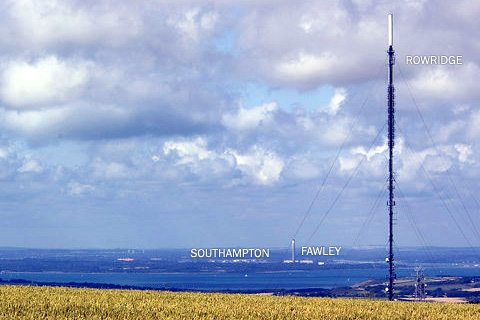
Although the coverage of the Fawley transmitter was not as widespread as that from Rowridge, in Southampton (the area of greatest economic interest) the Channel 5 analogue signal was good enough for most people to watch. Local TV channel Six TV also had a transmitter on the Fawley mast on channel 29 (also in-group) but with the slightly lower 4kW.
As with Six TV above, not all of the original analogue local TV stations used the main station masts.
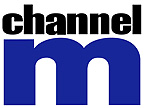 For example, Channel M in Manchester used a site on a water tower in Bolton. Like the Fawley solution for Southampton, this put the transmitter in roughly the right direction for viewers in Manchester whose antennas were pointed at the main station at Winter Hill. The frequency (channel 39) was, however, out of group and the transmitter pattern severely restricted to avoid interference with other transmitters and with the radioastronomy users at Jodrell Bank who used channel 38.
For example, Channel M in Manchester used a site on a water tower in Bolton. Like the Fawley solution for Southampton, this put the transmitter in roughly the right direction for viewers in Manchester whose antennas were pointed at the main station at Winter Hill. The frequency (channel 39) was, however, out of group and the transmitter pattern severely restricted to avoid interference with other transmitters and with the radioastronomy users at Jodrell Bank who used channel 38. 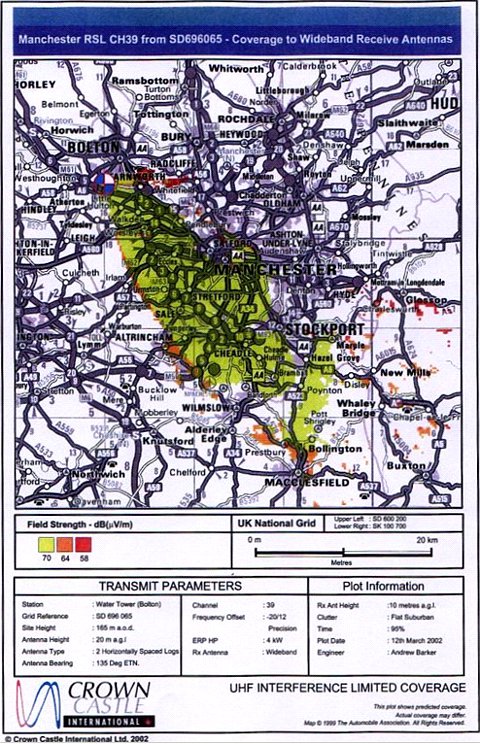 The upshot was that Channel M's signal was strong enough for good reception to a large number of viewers who were nearest to the water tower, but, conversely, coverage of Channel M in downtown Manchester was relatively poor (click on the map on the left to see it in full). Despite that, the station did better than many local TV companies and lasted for the best part of 12 years before finally closing down just before analogue services ended in the UK.
The upshot was that Channel M's signal was strong enough for good reception to a large number of viewers who were nearest to the water tower, but, conversely, coverage of Channel M in downtown Manchester was relatively poor (click on the map on the left to see it in full). Despite that, the station did better than many local TV companies and lasted for the best part of 12 years before finally closing down just before analogue services ended in the UK.What would have been great would to have been able to put more than one site on-air to provide additional coverage to fill-in coverage not-spots. In analogue terms this is difficult to do but for digital services such a solution is inherent to DTT in the form of a single frequency network (SFN). In an SFN multiple transmitters are put on the same frequency and as long as certain technical criteria are maintained (eg the distance between sites is small enough, ensuring that the transmitters are time and frequency synchronised, and that they carry the same content), they do not cause each other interference. In fact, the signals from multiple sites can even add together to improve coverage. If this sounds too good to be true, it is exactly how the digital audio broadcasting (DAB) multiplexes work.
So... Wouldn’t it be great if local TV in the digital age could take advantage of the use of SFNs to put a number of lower power (and thus much cheaper) transmitters right where their audiences are located, in line with existing masts (so that antennas don’t need re-pointing) and providing good coverage where the viewers are, but not wasting power or money on areas where few viewers are located? That is just the solution that Avanti’s bid to run the local TV multiplexes proposes. Whilst it might appear to be a ‘whacky, out-of-the-box’ type of solution, on the contrary it does what needs to be done in an efficient and effective way that has been proven to work well for local TV, even in the days of analogue transmission.
The jury (Ofcom) is still out on which of the bids to operate the multiplexes will succeed, but it is to be hoped that those making the decision are aware of the chequered history of local TV in the UK and don’t fall into the same traps that led to the commercial failure of the original analogue services in the 1990s and 2000s.
